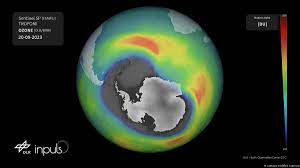Contrary to public perception, the Antarctic ozone hole has been amongst the largest on record over the past three years, new research has found. The ozone hole above Antarctica has been remarkably massive and long-lived over the past four years.
The core (middle stratospheric layer) of the Antarctic ozone in mid-spring (October) has experienced a 26% reduction since 2004, contrary to previously reported recovery trends in total ozone, according to a study published recently in the journal Nature Communications.
Ozone reduction
- The Montreal Protocol designated a list of controlled ozone depleting substances that were banned from future production in 1987 and is widely considered to have been successful for ozone recovery.
- However, the past three years (2020-2022) have witnessed the re-emergence of large and long-lived ozone holes over Antarctica in mid spring, while early spring still shows a slight ozone increase (or a slight recovery of the ozone hole).
- Understanding ozone variability remains of high importance, due to the major role Antarctic stratospheric ozone plays in climate variability across the Southern Hemisphere.
Assessment of Antarctic ozone hole
- To assess recent changes in the Antarctic ozone hole, including during the 2022 season, Scientists from the University of Otago, New Zealand and others analysed monthly and daily ozone changes between 2001-2022.
- Data from 2002 and 2019 were excluded as sudden stratospheric warming broke up the ozone hole anomalously early in these years.
- They looked at different stratospheric layers throughout the key austral springtime months of September to November.
Report
- When satellite data from 2022 is considered, they found that previously reported recovery trends in Antarctic spring total column ozone (the total ozone above a given point on Earth across all atmospheric layers) from 2001 onward disappear.
- The middle stratosphere has been dominated by continued, significant ozone reduction since 2004, amounting to 26% loss in the core of the ozone hole. This reduction is potentially driven by dynamical changes in the mesosphere (the atmospheric layer above the stratosphere and the ozone layer).
- The findings suggest that changes in the Southern Hemisphere atmosphere are contributing to a persistent Antarctic ozone hole.
The study cited changes in the Antarctic polar vortex (a vast swirl of low pressure and very cold air, high above the South Pole) as one of the main reasons for ozone depletion. It added that tiny, airborne particles emitted from wildfires and volcanoes and changes in solar cycle were also responsible for the depletion.
Contradiction in Claim
- Earlier this year, a report by the United Nations claimed that the ozone layer would be completely healed within two decades as the airborne chemicals that are destroying the atmospheric layer are declining. The chemicals called chlorofluorocarbons (CFCs) – once widely used in aerosols and refrigerators, were pointed as the major cause of ozone depletion.
- According to the report, the ozone layer will be restored to the 1980 levels by 2040 all over the world, 2045 over the Arctic, and by 2066 over the Antarctic.
- The report noted that ozone-damaging chlorine declined by 11.5 per cent in the stratosphere between its peak in 1993 and 2020, while bromine declined 14.5 per cent in the stratosphere between its peak in 1999 and 2020.
What is the Polar Vortex?
- The stratospheric polar vortex is a large-scale region of air that is contained by a strong west-to-east jet stream that circles the polar region.
- This jet stream is usually referred to as the polar night jet.
- The polar vortex extends from the tropopause (the dividing line between the stratosphere and troposphere) through the stratosphere and into the mesosphere (above 50 km).
- Low values of ozone and cold temperatures are associated with the air inside the vortex.
Southern hemisphere stratospheric vortex
- As with the northern hemisphere and the Arctic, there is also a southern hemisphere polar vortex.
- This polar vortex also extends through the stratosphere and into the mesosphere.
- In contrast to the northern vortex, the southern vortex is stronger, larger, and longer-lasting. In addition, temperatures are colder and ozone levels are lower than their northern counterpart.

